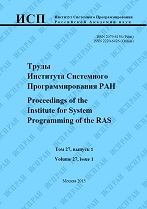|
Performance model of graphics pipeline for single-pass dynamic 3d scene rendering scheme
V. I. Gonakhchyan
Ivannikov Institute for System Programming of the RAS
Abstract:
The paper considers a single-pass scheme for rendering dynamic 3D scenes using modern GPUs and graphics interfaces. The following methods and techniques are used with this scheme: clipping of objects using spatial decomposition and indexing methods, hardware occlusion queries, fragmentation and caching of command buffers. These methods require significant computational resources to execute, and the amount of work in the stages of the graphics pipeline depends on their results. Therefore, a balanced use of resources when transferring graphics data and executing commands is important. A performance model of the graphics pipeline is proposed, which makes it possible to estimate the required resources depending on the applied base methods and characteristics of the displayed scene. Unlike existing methods and models, the proposed model allows to calculate the costs of composing command buffers using various recording techniques, the costs of sending, executing, and receiving the results of hardware occlusion queries. Formulas are derived to calculate frame rendering time depending on the number of occlusion queries. A method is proposed to estimate the number of occlusion queries for efficient rendering of dynamic scenes. Computational experiments are carried out to show the relevance of the proposed model and the effectiveness of the developed method when displaying large dynamic scenes. Section 1 provides an overview of related work as well as general purposes of given paper and its structure. Section 2 describes the proposed performance model and method used to calculate the number of occlusion queries for efficient rendering of dynamic scenes. Section 3 presents the performance analysis, which contains derived and measured rendering time when rendering scenes and employing frustum culling, occlusion queries. Section 4 summarizes the main conclusions.
Keywords:
3d rendering, command buffer recording, occlusion culling, hardware occlusion queries, performance model of graphics pipeline.
Citation:
V. I. Gonakhchyan, “Performance model of graphics pipeline for single-pass dynamic 3d scene rendering scheme”, Proceedings of ISP RAS, 32:4 (2020), 53–72
Linking options:
https://www.mathnet.ru/eng/tisp524 https://www.mathnet.ru/eng/tisp/v32/i4/p53
|

| Statistics & downloads: |
| Abstract page: | 133 | | Full-text PDF : | 80 | | References: | 28 |
|




 Contact us:
Contact us: Terms of Use
Terms of Use
 Registration to the website
Registration to the website Logotypes
Logotypes









 Citation in format
Citation in format 